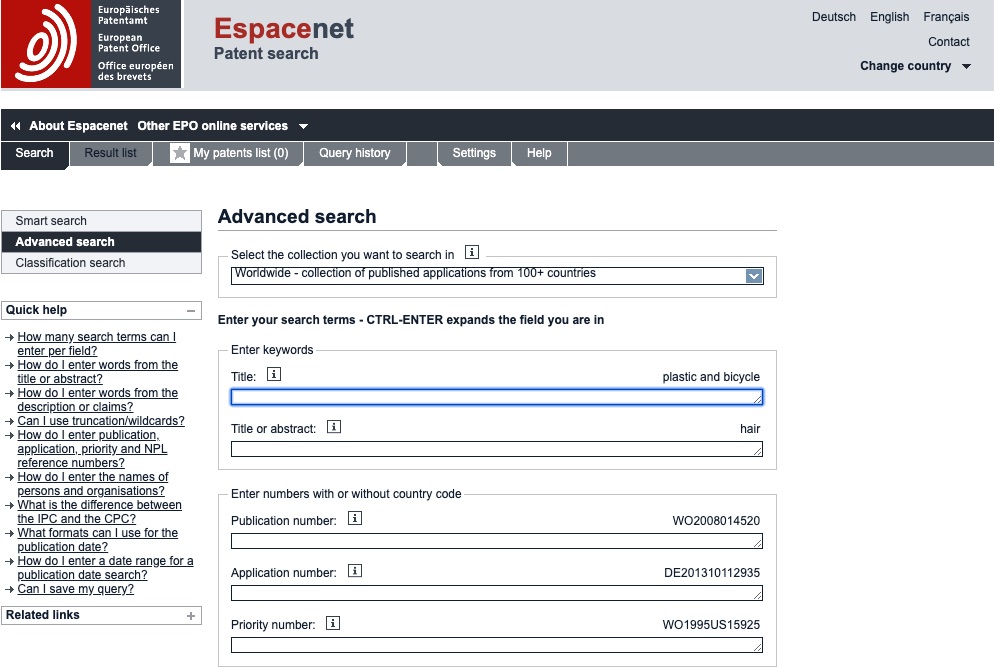Introduction – Espacenet Patent Search:
The main activity of the European Patent Office (EPO) is to examine and grant patent applications along with providing patent information and training services. Espacenet is the specially designed database of EPO, which offers patent information, giving free access to more than 110 million patent documents worldwide containing information about inventions and technical developments and hence helpful in the patent search process. Patent search prevents similar inventions and saves unnecessary expenditures of time, skill, and capital on research and development. The Espacenet database contains information on patents from 1782 till date, which is huge.
The EPO conducts a patent search through the search division which is entrusted with the responsibility of drafting search reports including the search opinions. The search is conducted with all the available documents in the office, other relevant documents and also covers internet sources, like online technical journals, online databases or other websites to determine the novelty and inventive steps involved in the invention.
Espacenet database is updated and can prove as a vital source of information for:
– searching and finding patent publications;
– machine translation of the patent documents;
– tracking the progress of emerging technologies;
– finding solutions to technical problems; and
– keeping a track of competitor product developments.
The EPO Guidelines for Examination Part B, Chapter II, states that the search must be as complete and effective as possible, within the limitations necessarily imposed by considerations such as invention, novelty and industrial applicability.
Search Strategy:
The EPO Guidelines for Examination Part B, Chapter IV provides for certain Search procedures and Strategies involved in the Patent Search.
1. Subject of the Search:
The user must first recognize the subject of invention and then prepare a search statement, defining the subject of search. The subject must be precise and consist of all important aspects of the invention. Any restrictions to the search must be indicated in the search report.
2. Formulating a search strategy:
The next step involved is formulating a search strategy which is basically a plan on the different documents to be relied on for the search. The user selects the classification groups to be consulted for the search and relies on indexing schemes and also consults their colleagues working in a particular technical field to gain additional information on the applied invention. When the user has a doubt on the appropriate fields to conduct the search, advice from the appropriate classification expert is taken. In considering whether to extend the search to other less relevant sections of the documentation, the user relies on the search results already obtained.
3. Carrying out the Search:
The user can use the documents available in the search tool to search for novelty, inventive step and industrial applicability of the applied invention. The search options that are available on Espacenet help in carrying out the search. The search options are:
i) Smart search engine is a simple tool and allows the user to enter keywords, name of applicants, numbers etc. and tries to guess what the user wants. It helps in narrowing down the results and resolves any kind of ambiguity
ii) Under Advanced search, the user has to enter the collection which he wants to search (for example: Worldwide collection of publication from 90 countries) and then the search terms like applicant’s name, title, priority number, abstract, inventor etc. can be entered which makes the search specific and hence ascertain efficient results.
iii) Classification search can be opted when the user is interested in finding all the patent publications in a particular technical area. Symbols that are assigned to patents classified into separate groups are entered in this search (for example like A43B49). Being a powerful tool used by professional patent searchers, it can take a while to get used to, but it is usually worth the effort.
4. Reformulation of the subject of the search:
The search strategy can be reformulated according to the information received in the process of the search. It depends on the judgment and skill of the user to decide whether they need to have a different outlook on the search documentation. The user must also be careful not to disclose any confidential information in the process of such patent searches.
5. Closest prior art and its effects on the search:
If the user is unable to find any similar existing invention, then the closest prior art to the applied invention can be cited. In other cases, where documents or inventions are found which are incidentally prejudicial to the novelty of the claimed invention but do not affect the inventive step, then appropriate changes are made to the claimed invention.
6. End of Search
The search comes to an end when the likeliness of discovering further relevant information or prior art becomes very low compared to the efforts put in for search. The search may also stop when relevant information is available proving that the claimed inventions have no novelty or other essential characteristics for an invention to be patented.
The final step to a patent search is preparing a search report attached with the opinion of experts regarding the invention and other documents, which are submitted to the applicant.
The main purpose of patent search is to provide opinions on Novelty/Uniqueness, Inventive Step and Industrial Applicability of the applied invention. After the patent search is conducted, the experts draft a search report attaching the results of patent search and providing opinion on whether the invention is eligible to patentability based on the considerations mentioned above.
While, conducting search for your invention in Espacenet might appear as a wonderful idea for beginners and for the ones who wish to conduct basic patentability searches for their invention. But for comprehensive and specific searches, it is always advisable to seek professional patent search.




